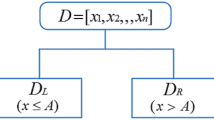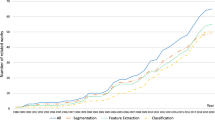Abstract
Purpose
In recent years, with the increasing incidence of cervical cancer, it is a tedious and time-consuming task with unsatisfying accuracy to manually recognize the cells. Machine recognition can be a good solution, but it suffers from the difficulty of obtaining precise edges of cells, which directly influence the final recognition accuracy. To improve the recognition accuracy and shorten the time used for cell recognition, an AGVF-Snake (Adaptive Gradient Vector Flow-Snake) model for the extraction of cell edges has been proposed in this paper.
Methods
Firstly, the cell is initially located by the improved Canny algorithm. Then, the adaptive initial contour model and gradient vector model are used to obtain accurate cell edges. Finally, the PSO–SVM (Particle Swarm Optimization-Support Vector Machine) classifier is selected to recognize the cervical cells.
Results
Herlev dataset is used to verify the AGVF-Snake algorithm; the accuracy of two and seven classifications are recorded. Six other classification methods are introduced for comparison. According to the experimental results, the accuracy of two and seven classifications can achieve up to 99%, which are better than other six methods.
Conclusion
The experiment results show that the proposed algorithm has obvious recognition advantages, and thus provides an effective methodological framework for the diagnosis of cervical cancer diseases.










Similar content being viewed by others
References
Lin ZH (2011) The cell image segmentation based on the K-L transform and OTSU method. In: 2011 IEEE multimedia and signal processing (CMSP). IEEE, pp 25–28. https://doi.org/10.1109/CMSP.2011.14
Mustafa N, Matisan A, Mashor MY (2009) Automated multicells segmentation of thin prep image using modified seed based region growing algorithm. Biomed Fuzzy Hum Sci 14:41–47
Guan T, Zhou DX, Liu YH (2015) Accurate segmentation of partially overlapping cervical cells based on dynamic sparse contour searching and GVF Snake model. IEEE J Biomed Health Inf 19:1494–1504
Thanatip C, Nipon T, Sansanee A (2009) Cervical cell classification using Fourier transform. In: 13th international conference on biomedical engineering. Springer, Berlin, pp 476–480
Chen YF, Huang PC, Lin KC, Lin HH, Wang LE, Cheng CC, Chen TP, Chan YK, Chiang JY (2014) Semi-automatic segmentation and classification of pap smear cells. IEEE J Biomed Health Inf 18:94–108
Singh S, Tejaswini V, Murthy RP, Mutgi A (2015) Neural network based automated system for diagnosis of cervical cancer. Int J Biomed Clin Eng (IJBCE) 4:26–39
Chen CL, Mahjoubfar A, Tai LC (2016) Deep learning in label-free cell classification. Sci Rep. https://doi.org/10.1038/srep21471
Wu J, Lu MY, Liu C (2010) SVM-based scheme within hybrid learning framework for image retrieval. Acta Electron Sin 38:2101–2106
Chen GC, Yu JS (2005) Particle swarm optimization algorithm. Inf Control 34:318–323
Geusebroek JM, Smeulders AWM,Vande WJ(2003) Fast anisotropic Gauss filtering. In: 2003 IEEE transactions image processing. IEEE, 12(8), pp 938–943. https://doi.org/10.1109/TIP.2003.812429
Wang L, Xu TT (2016) An improved Canny algorithm in the GVF Snake model. Comput Eng 42:231–235
Jin YH (2011) Research on image edge detection based on improved canny algorithm. Dissertation, Chongqing Normal University
Xu CY, Peince JL (1997) Gradient vector flow: a new external force for Snakes. In: 1997 IEEE proceedings of 1997 conference on computer vision and pattern recognition. IEEE, pp 66–71. https://doi.org/10.1109/CVPR.1997.609299
Xu CY, Prince JL (1998) Generalized gradient vector flow external forces for active contours. Signal Process 71:131–139. https://doi.org/10.1016/S0165-1684(98)00140-6
Cheng JR, Foo SW, Krishnan SM (2006) Dynamic directional gradient vector flow for Snakes. In: 2006 IEEE transactionson image processing. IEEE, pp 1563–1571. https://doi.org/10.1109/ISSPIT.2004.1433748
Xiang Y, Chung ACS, Ye J (2006) An active contour model for image segmentation based on elastic interaction. J Comput Phys 219:455–476. https://doi.org/10.1016/j.jcp.2006.03.026
Xu CY, Yezzi AJ, Prince JL (2000) In: 2000 IEEE on the relationship between parametric and geometric active contours, pp 483–489. https://doi.org/10.1109/ACSSC.2000.911003
Zijdenbos AP, Dawant BM, Margolin RA, Palmer AC (1994) Morphometric analysis of white matter lesion in MR images: method and validation. IEEE Trans Med Imaging 13(4):716–724. https://doi.org/10.1109/42.363096
Thanatip C, Nipon T, Sansanee A (2014) Automatic cervical cell segmentation and classification in pap smears. Comput Methods Programs Biomed 113:539–556. https://doi.org/10.1016/j.cmpb.2016.10.001
Li K, Lu Z, Liu WY, Yin JP (2012) Cytoplasm and nucleus segmentation in cervical smear images using radiating GVF Snake. Pattern Recognit 45(4):1255–1264. https://doi.org/10.1016/j.patcog.2011.09.018
Kale K, Aksoy S(2010)Segmentation of cervical cell images. In: Proceedings of the 20th IAPR international conference on pattern recognition, Istanbul, Turkey. https://doi.org/10.1109/icpr.2010.587
Erik M (2003) Pap-smear classification, Denmark
Zhao M, Wu AG, Song JJ, Sun XG, Dong N (2016) Automatic screening of cervical cells using block image processing. Biomed Eng. https://doi.org/10.1186/s12938-016-0131-z
Bora K, Manish C, Li P, Malay KK, Anup KD (2017) Automated classification of Pap smear images to detect cervical dysplasia. Comput Methods Programs Biomed 138:31–47. https://doi.org/10.1016/j.cmpb.2016.10.001
Zhang L, Lu L, Nogues J, Ronald MS, Liu SX, Yao JH (2017) DeepPap: deep convolutional networks for cervical cell classification. IEEE J Biomed Health Inf 21:1633–1643. https://doi.org/10.1109/JBHI.2017.2705583
Sajeena TA, Jereesh AS (2015) Automated cervical cancer detection through RGVF segmentation and SVM classification. In: 2015 International conference on computing and network communications, pp 16–19. https://doi.org/10.1109/CoCoNet.2015.7411260
Jayasingh ME, Allwin S (2015) Nominated texture based cervical cancer classification. Comput Math Methods Med 2015:1–10
Acknowledgements
The authors would like to thank the associate editor and reviewers for their valuable comments and suggestions that improved the paper’s quality.
Funding
This study was funded by the Nature Science Foundation (Grant Number 61773282).
Author information
Authors and Affiliations
Corresponding author
Ethics declarations
Conflict of interest
The authors declare that they have no conflict of interest.
Informed consent
This article does not contain patient data.
Human and animal rights
This article does not contain any studies with human participants or animals performed by any of the authors.
Additional information
Publisher’s Note
Springer Nature remains neutral with regard to jurisdictional claims in published maps and institutional affiliations.
Rights and permissions
About this article
Cite this article
Dong, N., Zhao, L. & Wu, A. Cervical cell recognition based on AGVF-Snake algorithm. Int J CARS 14, 2031–2041 (2019). https://doi.org/10.1007/s11548-019-01961-x
Received:
Accepted:
Published:
Issue Date:
DOI: https://doi.org/10.1007/s11548-019-01961-x




